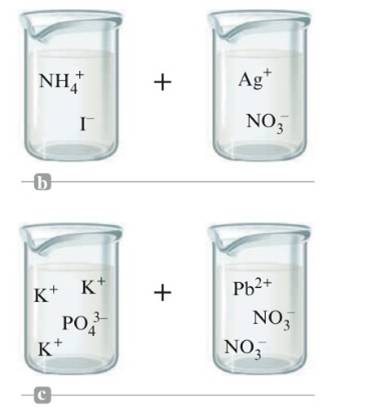
Bundle: Introductory Chemistry: A Foundation, 8th + OWLv2 6-Months Printed Access Card
8th Edition
ISBN: 9781305367333
Author: Steven S. Zumdahl, Donald J. DeCoste
Publisher: Cengage Learning
expand_more
expand_more
format_list_bulleted
Textbook Question
Chapter 7, Problem 16ALQ
On the basis of the general solubility rules given in Table 7.1, predict the identity of the precipitate that forms when aqueous solutions of the following Substances are mixed. If no precipitate is likely, indicate which rules apply.
mg src=Images/HTML_99425-7-16ALQ_image001.jpg alt="" align="top"/>

Expert Solution & Answer
Trending nowThis is a popular solution!

Students have asked these similar questions
At an electrified interface according to the Gouy-Chapman model, what types of interactions do NOT occur between the ions and the solvent according to this theory?
Please predict the products for each of the
following reactions.
Clearly show the regiochemistry (Markovnikov
vs anti-Markovnikov) and stereochemistry
(syn- vs anti- or both).
If a mixture of enantiomers is formed, please
draw all the enantiomers.
Hint: In this case you must choose the best
answer to demonstrate the stereochemistry of
H2 addition.
1.03
2. (CH3)2S
BIZ
CH₂OH
2. DMS
KMnO4, NaOH
ΖΗ
Pd or Pt (catalyst)
HBr
20 1
HBr
ROOR (peroxide)
HO
H-SO
HC
12 11 10
BH, THE
2. H2O2, NaOH
Brz
cold
HI
19
18
17
16
MCPBA
15
14
13
A
Br
H₂O
BH3⚫THF
Brz
EtOH
Pd or Ni (catalyst)
D₂ (deuterium)
1. Os04
2. H2O2
CH3CO3H
(peroxyacid)
1. MCPBA
2. H₂O*
H
B
+
H
H
H
"H
C
H
H
D
Explain how Beer’s Law can be used to determine the concentration in a selected food sample. Provide examples.
Chapter 7 Solutions
Bundle: Introductory Chemistry: A Foundation, 8th + OWLv2 6-Months Printed Access Card
Ch. 7.2 - at if no ionic solids were soluble in water? Could...Ch. 7.2 - Prob. 7.1SCCh. 7.3 - trong>Exercise 7.2 For each of the following...Ch. 7.5 - Prob. 7.3SCCh. 7.7 - lton believed that atoms were indivisible. Thomson...Ch. 7.7 - ercise 7.4 Classify each of the following...Ch. 7 - onsider the mixing of aqueous solutions of...Ch. 7 - ssume a highly magnified view of a solution of HCI...Ch. 7 - hy is the formation of a solid evidence of a...Ch. 7 - Prob. 4ALQ
Ch. 7 - ixing an aqueous solution of potassium nitrate...Ch. 7 - Prob. 6ALQCh. 7 - se the Arrhenius definition of acids and bases to...Ch. 7 - Prob. 8ALQCh. 7 - hy is the formation of a gas evidence of a...Ch. 7 - Label each of the following statements as true or...Ch. 7 - Look at Fig. 7.2 in the text. It is possible for a...Ch. 7 - What is the purpose of spectator ions? If they are...Ch. 7 - Which of the following must be an...Ch. 7 - If an element is a reactant or product in a...Ch. 7 - Prob. 15ALQCh. 7 - On the basis of the general solubility rules given...Ch. 7 - Write the balanced formula and net ionic equation...Ch. 7 - hy is water an important solvent? Although you...Ch. 7 - hat is a “driving force”? What are some of the...Ch. 7 - Prob. 3QAPCh. 7 - Prob. 4QAPCh. 7 - escribe briefly what happens when an ionic...Ch. 7 - hen the ionic solute K3PO4is dissolved in water,...Ch. 7 - Prob. 7QAPCh. 7 - ow do chemists know that the ions behave...Ch. 7 - uppose you are trying to help your friend...Ch. 7 - Using the general solubility rules given in Table...Ch. 7 - On the basis of the general solubility rules given...Ch. 7 - On the basis of the general solubility rules given...Ch. 7 - On the basis of the general solubility rules given...Ch. 7 - On the basis of the general solubility rules given...Ch. 7 - On the basis of the general solubility rules given...Ch. 7 - Prob. 16QAPCh. 7 - On the basis of the general solubility rules given...Ch. 7 - On the basis of the general solubility rules given...Ch. 7 - Balance each of the following equations that...Ch. 7 - Balance each of the following equations that...Ch. 7 - For each of the following precipitation reactions,...Ch. 7 - A solution of zinc nitrate is mixed with a...Ch. 7 - What is a net ionic equation? What species are...Ch. 7 - Prob. 24QAPCh. 7 - Based on the general solubility rules given in...Ch. 7 - Write the balanced molecular, complete ionic, and...Ch. 7 - Many chromate salts are insoluble, and most have...Ch. 7 - The procedures and principles of qualitative...Ch. 7 - Many plants are poisonous because their stems and...Ch. 7 - Prob. 30QAPCh. 7 - What is meant by a strong acid? Are the strong...Ch. 7 - What is meant by a strong base? Are the strong...Ch. 7 - The same net ionic process takes place when any...Ch. 7 - Prob. 34QAPCh. 7 - If 1000 NaOH units were dissolved in a sample of...Ch. 7 - What is a salt? Give two balanced chemical...Ch. 7 - Write balanced equations showing how three of the...Ch. 7 - Prob. 38QAPCh. 7 - What salt would form when each of the following...Ch. 7 - Prob. 40QAPCh. 7 - Prob. 41QAPCh. 7 - Give an example of a simple chemical reaction that...Ch. 7 - What do we mean when we say that the transfer of...Ch. 7 - Prob. 44QAPCh. 7 - If atoms of the metal calcium were to react with...Ch. 7 - If oxygen molecules, were to react with magnesium...Ch. 7 - Prob. 47QAPCh. 7 - Prob. 48QAPCh. 7 - Prob. 49QAPCh. 7 - Prob. 50QAPCh. 7 - Prob. 51QAPCh. 7 - The reaction between ammonium perchlorate and...Ch. 7 - Identify each of the following unbalanced reaction...Ch. 7 - Prob. 54QAPCh. 7 - Prob. 55QAPCh. 7 - Prob. 56QAPCh. 7 - What is a synthesis or combination reaction? Give...Ch. 7 - What is a decomposition reaction? Give an example....Ch. 7 - Complete and balance each of the following...Ch. 7 - Prob. 60QAPCh. 7 - Prob. 61QAPCh. 7 - Prob. 62QAPCh. 7 - Balance each of the following equations that...Ch. 7 - Prob. 64QAPCh. 7 - Balance each of the following equations that...Ch. 7 - Prob. 66QAPCh. 7 - Distinguish between the molecular equation, the...Ch. 7 - Prob. 68APCh. 7 - Without first writing a full molecular or ionic...Ch. 7 - Complete and balance each of the following...Ch. 7 - Prob. 71APCh. 7 - Prob. 72APCh. 7 - Prob. 73APCh. 7 - Prob. 74APCh. 7 - For each of the following unbalanced molecular...Ch. 7 - Write the balanced molecular, complete ionic, and...Ch. 7 - What strong acid and what strong base would react...Ch. 7 - Prob. 78APCh. 7 - For the reaction 16Fe(s)+3S8(s)8Fe2S3(s), show how...Ch. 7 - Prob. 80APCh. 7 - Identify each of the following unbalanced reaction...Ch. 7 - Which of the following statements is/are true...Ch. 7 - Prob. 83APCh. 7 - Prob. 84APCh. 7 - Prob. 85APCh. 7 - Prob. 86APCh. 7 - Prob. 87APCh. 7 - For each of the following metals, how many...Ch. 7 - For each of the following nonmetals, how many...Ch. 7 - True or false? When solutions of barium hydroxide...Ch. 7 - Classify the reactions represented by the...Ch. 7 - When a sodium chromate solution and aluminum...Ch. 7 - Prob. 93APCh. 7 - Consider a solution with the following ions...Ch. 7 - Prob. 95APCh. 7 - For the following chemical reactions, determine...Ch. 7 - Prob. 97CPCh. 7 - hat kind of visual evidence indicates that a...Ch. 7 - Prob. 2CRCh. 7 - Prob. 3CRCh. 7 - Prob. 4CRCh. 7 - hat is meant by the driving force for a reaction?...Ch. 7 - xplain to your friend what chemists mean by a...Ch. 7 - efine the term strong electrolyte. What types of...Ch. 7 - ummarize the simple solubility rules for ionic...Ch. 7 - n general terms, what are the spectator ions in a...Ch. 7 - Describe some physical and chemical properties of...Ch. 7 - Prob. 11CRCh. 7 - What do we call reactions in which electrons are...Ch. 7 - What is a combustion reaction? Are combustion...Ch. 7 - Prob. 14CRCh. 7 - List and define all the ways of classifying...Ch. 7 - The element carbon undergoes many inorganic...Ch. 7 - Prob. 17CRCh. 7 - The reagent shelf in a general chemistry lab...Ch. 7 - Prob. 19CRCh. 7 - Prob. 20CRCh. 7 - Prob. 21CRCh. 7 - Prob. 22CRCh. 7 - Using the general solubility rules discussed in...Ch. 7 - Write the balanced net ionic equation for the...Ch. 7 - Prob. 25CR
Knowledge Booster
Learn more about
Need a deep-dive on the concept behind this application? Look no further. Learn more about this topic, chemistry and related others by exploring similar questions and additional content below.Similar questions
- Explain the importance of having a sampling plan with respect to food analysis. Explain the importance of having a sampling plan with respect to food analysis. Provide examples.arrow_forwardPlease predict the products for each of the following reactions. Clearly show the regiochemistry (Markovnikov vs anti-Markovnikov) and stereochemistry (syn- vs anti- or both). If a mixture of enantiomers is formed, please draw all the enantiomers. cold KMnO4, NaOH 2. DMS 1. 03 CH3OH Br2 1. 03 2. (CH3)2S H₂ Pd or Pt (catalyst) HBr 18 19 20 1 HBr ROOR (peroxide) H₂O H₂SO4 HCI HI 17 16 6 15 MCPBA 1. BH3 THF 2. H₂O2, NaOH 1. OsO4 2. H₂O₂ 110 CH3CO₂H (peroxyacid) 1. MCPBA 2. H₂O* Br2 H₂O BH3 THF B12 EtOH Pd or Ni (catalyst) D₂ (deuterium) Bra A B C D H OH H OH OH H OH α α α OH H OH OH фон d H "Harrow_forwardBriefly indicate the models that describe the structure of the interface: Helmholtz-Perrin, Gouy-Chapman, Stern and Grahame models.arrow_forward
- Using Benzene as starting materid show how each of the Following molecules Contel Ve syntheswed CHI 9. b -50311 с CHY 503H Ночто d. อ •NOV e 11-0-650 NO2arrow_forwardThe molecule PYRIDINE, 6th electrons and is therefore aromatre and is Assigned the Following structure contering Since aromatk moleculoy undergo electrophilic anomatic substitution, Pyridine shodd undergo The Following reaction + HNO3 12504 a. write all of the possible Mononitration Products that could Result From this reaction 18. Bared upon the reaction mechanison determime which of these producty would be the major Product of the hegetionarrow_forwarda. Explain Why electron withdrawing groups tend to be meta-Directors. Your answer Should lyclude all apropriate. Resonance contributing Structures fo. Explain why -ll is an outho -tura drccton even though chlorine has a very High Electronegativityarrow_forward
arrow_back_ios
SEE MORE QUESTIONS
arrow_forward_ios
Recommended textbooks for you
 Chemistry: Principles and PracticeChemistryISBN:9780534420123Author:Daniel L. Reger, Scott R. Goode, David W. Ball, Edward MercerPublisher:Cengage Learning
Chemistry: Principles and PracticeChemistryISBN:9780534420123Author:Daniel L. Reger, Scott R. Goode, David W. Ball, Edward MercerPublisher:Cengage Learning Introductory Chemistry: An Active Learning Approa...ChemistryISBN:9781305079250Author:Mark S. Cracolice, Ed PetersPublisher:Cengage Learning
Introductory Chemistry: An Active Learning Approa...ChemistryISBN:9781305079250Author:Mark S. Cracolice, Ed PetersPublisher:Cengage Learning Introductory Chemistry: A FoundationChemistryISBN:9781337399425Author:Steven S. Zumdahl, Donald J. DeCostePublisher:Cengage Learning
Introductory Chemistry: A FoundationChemistryISBN:9781337399425Author:Steven S. Zumdahl, Donald J. DeCostePublisher:Cengage Learning Chemistry: The Molecular ScienceChemistryISBN:9781285199047Author:John W. Moore, Conrad L. StanitskiPublisher:Cengage Learning
Chemistry: The Molecular ScienceChemistryISBN:9781285199047Author:John W. Moore, Conrad L. StanitskiPublisher:Cengage Learning Chemistry: Principles and ReactionsChemistryISBN:9781305079373Author:William L. Masterton, Cecile N. HurleyPublisher:Cengage Learning
Chemistry: Principles and ReactionsChemistryISBN:9781305079373Author:William L. Masterton, Cecile N. HurleyPublisher:Cengage Learning ChemistryChemistryISBN:9781305957404Author:Steven S. Zumdahl, Susan A. Zumdahl, Donald J. DeCostePublisher:Cengage Learning
ChemistryChemistryISBN:9781305957404Author:Steven S. Zumdahl, Susan A. Zumdahl, Donald J. DeCostePublisher:Cengage Learning

Chemistry: Principles and Practice
Chemistry
ISBN:9780534420123
Author:Daniel L. Reger, Scott R. Goode, David W. Ball, Edward Mercer
Publisher:Cengage Learning

Introductory Chemistry: An Active Learning Approa...
Chemistry
ISBN:9781305079250
Author:Mark S. Cracolice, Ed Peters
Publisher:Cengage Learning

Introductory Chemistry: A Foundation
Chemistry
ISBN:9781337399425
Author:Steven S. Zumdahl, Donald J. DeCoste
Publisher:Cengage Learning

Chemistry: The Molecular Science
Chemistry
ISBN:9781285199047
Author:John W. Moore, Conrad L. Stanitski
Publisher:Cengage Learning

Chemistry: Principles and Reactions
Chemistry
ISBN:9781305079373
Author:William L. Masterton, Cecile N. Hurley
Publisher:Cengage Learning

Chemistry
Chemistry
ISBN:9781305957404
Author:Steven S. Zumdahl, Susan A. Zumdahl, Donald J. DeCoste
Publisher:Cengage Learning
Thermogravimetric Analysis [ TGA ] # Thermal Analysis # Analytical Chemistry Part-11# CSIR NET/GATE; Author: Priyanka Jain;https://www.youtube.com/watch?v=p1K-Jpzylso;License: Standard YouTube License, CC-BY